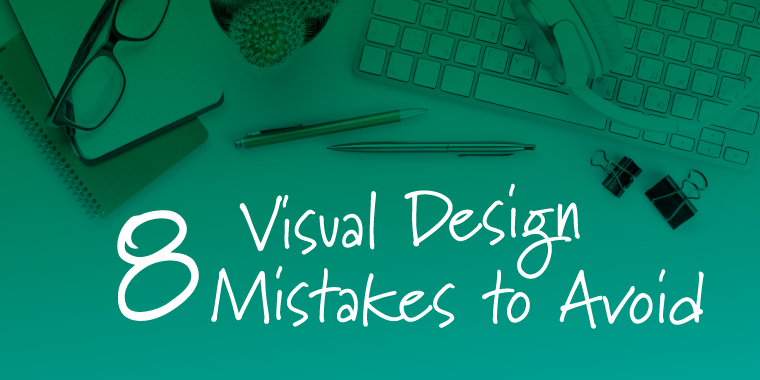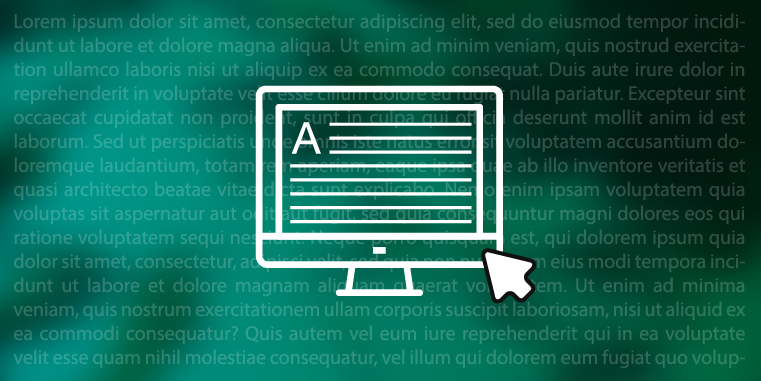
8 Visual Design Mistakes to Avoid When Developing eLearning
When developing an eLearning course, it’s easy to put all of your focus towards the instructional design aspects of the course. And while instructional design is a vital component to the effectiveness of an eLearning course, other elements can either help elevate your course content or detract from it. One of these elements includes visual design.
When you’re new to eLearning, it’s easy to make some fundamental visual design mistakes when creating a course. However, with some attention to detail, along with some simple tips, these visual design mistakes don’t have to be hard to fix.
Here are my top eight visual design mistakes you should avoid when developing your next eLearning course and how to fix them!
#1: Distorted Images

A distorted image is a classic visual design mistake I see all the time, and it’s mostly an issue with attention to detail when resizing an image. An image gets distorted when the image is resized in such a way that it affects the aspect ratio of the image (i.e., scaling the image too tall or too wide). This results in the image looking stretch and distorted.
For those of you who know what I’m talking about, you can spot a distorted image from a mile away—even if it’s just a pixel off.
How to avoid this visual design mistake.
The easiest way to avoid distorted images is to resize an image from the corner. Most design programs, including PowerPoint and Articulate Storyline, will maintain the aspect ratio of an image when resized from the corner. With other programs, you can avoid this by holding the Shift key when resizing the image, which usually locks the aspect ratio.
#2: Misaligned & Misdistributed Objects

Misaligned and misdistributed objects is another attention to detail issue, which is common amongst new eLearning designers. Text, shapes, or images usually get misaligned or misdistributed when they are placed on the screen and aligned or distributed manually. This is another visual design mistake, that once you start noticing it, you’d rather die than not fix it.
How to avoid this visual design mistake.
The best way to avoid misaligned and misditributed objects is to master the use of the align and distribute tools included in most eLearning and design programs. Most programs, like PowerPoint and Articulate Storyline, also offer the option to display a grid or visual guides, which can be used for evenly aligning and distributing objects on the screen.
#3: Too Much Text

eLearning is a tool for visual communications; however, it’s easy to fill your screen with too much text. The great thing about eLearning is that it lets you take advantage of many different types of media to communicate your message, beyond plain text. Images, videos, audio, illustrations, and animations can be combined with text to create a more holistic multimedia experience.
How to avoid this visual design mistake.
You can avoid this mistake by finding opportunities to visually communicate your ideas. If you plan to include audio narration in your course, find ways to visualize the messages being delivered in the narration with images, graphics, and animations.
#4: Bad Color Choices

The use of color can have a massive impact on how your course is perceived by your learners. Besides the need to stick with specific colors for branding purposes, certain colors can affect the overall tone and mood of your course. Some color combinations can also make it harder to read text on the screen.
How to avoid this visual design mistake.
You can avoid this visual design mistake by following some simple rules when it comes to using colors. If you work for a large organization, it’s likely that your company has a style guide, with specific rules for the use of color. If you need to make your own custom design, there are many different tools that can help you create your own custom eLearning color scheme.
#5: Low-Quality Images

A low-quality image is something that’s immediately recognizable, even for non-graphic designers. No one wants their eLearning courses to look cheap. Picking images that are pixelated, have bad lighting, or look dated can make your learners question the overall quality of the course, and more importantly, the content itself.
How to avoid this visual design mistake.
Avoiding this visual design mistake is easy: stop using low-quality images! If when you use an image and notice that it’s pixelated, that’s your cue to go find a different image of a higher-quality. Luckily, it’s becoming much easier to find free stock images. Here are 10 free stock photo sites that I use on a regular basis when I’m designing eLearning.
#6: Mismatched Fonts

Just like the use colors, it’s easy to mismatch or use too many fonts. When used improperly, picking the wrong fonts can make your content hard to read or become distracting.
How to avoid this visual design mistake.
Avoid mismatched fonts by either sticking to your company style guide or by following some simple rules for pairing fonts. Also, regardless of which fonts you use, the most important thing is to be consistent with them. If you pick three fonts to use throughout your course, stick with those three fonts religiously.
#7: Too Many Bullet Points

Not using too many bullet points is a rule we all seem to know, but end up breaking all the time. When an eLearning course is full of bullet points, its a sign to me that the designer didn’t spend enough time refining their content and considering how to communicate it on the screen.
How to avoid this visual design mistake.
You can avoid using too many bullet points by just removing them, or by transforming them into a meaningful graphic. When you take the time to think about the messaging in each of your bullet points, you can usually find an icon, image, or graphic to represent what it is you want to say.
#8: Bad Stock Photos

While it’s easy to use stock photos when designing an eLearning course, you want to avoid using bad stock photos! The truth is, there isn’t an easy way to define what makes a bad stock photo—bad stock photos look staged, cheesy, unrealistic, and dated. The risk of using back stock photos can lead to making your course looking cheap, or making it harder for your learners to connect to the content.
How to avoid this visual design mistake.
You want to avoid this visual design mistake by trying to avoid stock photos that look like, well, stock photos. Try to find images that look like real people, doing real things. Photos that appear to show individuals in posed positions or unrealistic office spaces will end up looking generic.
What other visual design mistakes should be avoided when developing eLearning? Share them by commenting below!




Hi Tim!
Great tips! A couple additional visual design mistakes (I think these fall under ‘visual’ mistakes?) that I tend to send back to production include:
1) Those floating people – With the popular use of cut-out photographic characters, I also see a lot of characters who appear to be levitating, seemingly lost in a white background. I think a person should be grounded – on a floor, in a chair, in a background scene. At a minimum, a person can be grounded by aligning them with the bottom of the slide, especially if you have chopped them off at the waist. 😉
2) Animation overload – You can fix all of the common visual design mistakes – but the way you make them appear can still hurt. I love some fun animation to bring the content to life, but when images or text are flying in, growing, or spinning inconsistently and from too many directions, you just don’t know where to look. Use of animation should be strategic, consistent and restrained.
3) Location, location, location – Stationary design elements (i.e., a logo, custom navigation buttons, text headings, etc.) that appear to ‘jump’ around from slide to slide are distracting. Your eye is immediately drawn to the inconsistency in placement that appears as movement, when you should be looking at the new content. Use the X: and Y: positions to ensure consistency and smooth transitions.
Hi Tonna! Thanks for the comment! I SO agree with everything you’ve mentioned. These are things I see all the time. I’m totally with you on #3. I hate it when I see an object jump, even when it’s just a pixel or two. Thanks again for sharing! These are great!
This is great advice, Tim. I have a perplexing issue though… I use (IMHO) very high quality cut out characters from eLearning Brothers in my lessons and an executive-level reviewer recently stated that she does not like them. I tried to explain that learners connect with the subject matter when they visualize themselves in the task the eLearning is trying to get them to do. I continued, these characters, that look like our employees, help with that connection. She responded, eh… I just don’t like them, take em out…
After reading your #8 here I wonder if these characters that I consider high quality do make my courses look cheap…?
What are your thoughts on this?
Thanks for reading, Bryan! Regarding your question about the characters…I think it depends. Personally, I’m not a fan of using characters for the sake of using characters. Too often, I see them inserted into eLearning courses as a design embellishment, but it really serves no purpose. For me, I like using characters when the characters are actually integrated into the content. For example, if you’re telling a story and the character represents someone in the narrative…or if you’re designing an eLearning scenario, and the character is playing a role in the scenario. In both of those situations, I think the characters work. It all comes down to what your intention is in using them. I hope that makes sense!
Here’s a separate post I wrote on the topic: https://timslade.com/blog/using-characters-in-e-learning/